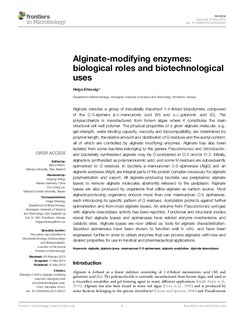| dc.contributor.author | Ertesvåg, Helga | |
| dc.date.accessioned | 2015-09-30T07:16:23Z | |
| dc.date.accessioned | 2015-11-05T09:45:31Z | |
| dc.date.available | 2015-09-30T07:16:23Z | |
| dc.date.available | 2015-11-05T09:45:31Z | |
| dc.date.issued | 2015 | |
| dc.identifier.citation | Frontiers in Microbiology 2015, 6 | nb_NO |
| dc.identifier.issn | 1664-302X | |
| dc.identifier.uri | http://hdl.handle.net/11250/2359375 | |
| dc.description.abstract | Alginate denotes a group of industrially important 1-4-linked biopolymers composed of the C-5-epimers β-D-mannuronic acid (M) and α-L-guluronic acid (G). The polysaccharide is manufactured from brown algae where it constitutes the main structural cell wall polymer. The physical properties of a given alginate molecule, e.g. gel-strength, water-binding capacity, viscosity and biocompatibility, are determined by polymer length, the relative amount and distribution of G residues and the acetyl content, all of which are controlled by alginate modifying enzymes. Alginate has also been isolated from some bacteria belonging to the genera Pseudomonas and Azotobacter, and bacterially synthesized alginate may be O-acetylated at O-2 and/or O-3. Initially, alginate is synthesized as polymannuronic acid, and some M residues are subsequently epimerized to G residues. In bacteria a mannuronan C-5-epimerase (AlgG) and an alginate acetylase (AlgX) are integral parts of the protein complex necessary for alginate polymerisation and export. All alginate-producing bacteria use periplasmic alginate lyases to remove alginate molecules aberrantly released to the periplasm. Alginate lyases are also produced by organisms that utilize alginate as carbon source. Most alginate-producing organisms encode more than one mannuronan C-5 epimerase, each introducing its specific pattern of G residues. Acetylation protects against further epimerization and from most alginate lyases. One enzyme with alginate deacetylase activity from Pseudomonas syringae has been reported. Functional and structural studies reveal that alginate lyases and epimerases have related enzyme mechanisms and catalytic sites. Alginate lyases are now utilized as tools for alginate characterization. Secreted epimerases have been shown to function well in vitro, and have been engineered further in order to obtain enzymes that can provide alginates with new and desired properties for use in medical and pharmaceutical applications. | nb_NO |
| dc.language.iso | eng | nb_NO |
| dc.publisher | Frontiers | nb_NO |
| dc.title | Alginate-modifying enzymes: Biological roles and biotechnological uses | nb_NO |
| dc.type | Journal article | nb_NO |
| dc.type | Peer reviewed | en_GB |
| dc.date.updated | 2015-09-30T07:16:23Z | |
| dc.source.volume | 6 | nb_NO |
| dc.source.journal | Frontiers in Microbiology | nb_NO |
| dc.identifier.doi | 10.3389/fmicb.2015.00523 | |
| dc.identifier.cristin | 1242190 | |
| dc.relation.project | Norges forskningsråd: 221576 | nb_NO |
| dc.description.localcode | © 2015 Ertesvåg. This is an open-access article distributed under the terms of the Creative Commons Attribution License (CC BY). The use, distribution or reproduction in other forums is permitted, provided the original author(s) or licensor are credited and that the original publication in this journal is cited, in accordance with accepted academic practice. No use, distribution or reproduction is permitted which does not comply with these terms. | nb_NO |
